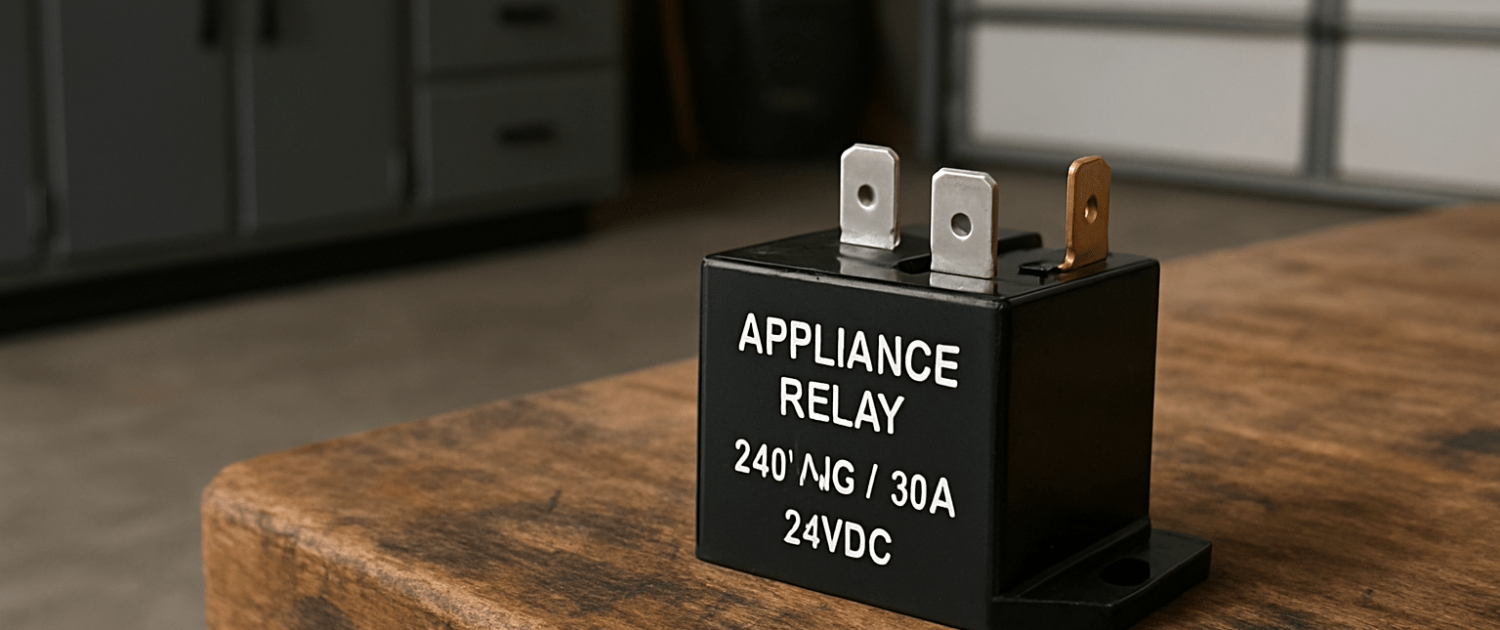Relays in Home Appliances: What They Do and How They Work
Steven E / Friday July 11, 2025
Ever wonder what actually controls the power in your appliances? That little “click” you sometimes hear when your washer or oven starts up? That’s likely a relay at work! Relays are tiny but mighty electrical switches that help your appliances operate safely and efficiently. Here’s a quick look at how relays work in appliances and why they matter.
The information in this article may not apply to your specific appliance model. We recommend consulting your manufacturer’s documentation or contact us with any questions.
What Is a Relay?
A relay is an electrical switch that is operated by an electric current rather than by hand. In other words, it’s a small part that opens or closes a circuit to allow power to flow to another part of the appliance, or stop it when needed.
Relays are used in appliances to control high-power circuits with low-power signals. This allows for more precise control without sending a large current through sensitive parts of the appliance.
At its core, a relay contains:
- Coil: An electromagnet that activates the switch when energized.
- Contacts: Metal points that open or close to complete or break the circuit.
- Spring or armature: A mechanical part that moves the contacts into position when the coil is energized.
When the coil is energized, it creates a magnetic field that moves the armature and changes the position of the contacts. When the coil is de-energized, a spring returns the armature and contacts to their original state.
Why Relays Are Important in Appliances
Relays are used in appliances because they make it possible to safely control powerful parts like motors, compressors, and heating elements without sending full power through sensitive control circuits.
Here are some of the benefits of using relays:
- Allow low-voltage control over high-voltage circuits
- Isolate sensitive electronics from high power
- Enable timed or delayed operations
- Improve energy efficiency by only powering parts when needed
Without relays, your appliances would have to rely on much heavier wiring and more complex control systems, making them more expensive and less reliable.
Common Places You’ll Find Relays
Relays are used in many different appliances in your home. Here are a few examples of where you might encounter them:
Refrigerators
- Start relay: Helps the compressor motor start by providing an extra boost of current.
- Defrost relay: Controls the heating part used to melt frost on the evaporator coils.
Dishwashers
- Heater relay: Switches the heating element on and off during the drying cycle.
- Motor relay: Controls the main wash motor.
Washing Machines
- Motor relay: Starts and stops the motor that spins the drum.
- Water valve relay: Opens and closes the valves that let water into the tub.
Dryers
- Motor relay: Controls the blower and drum motor.
- Heater relay: Turns the heating part on and off to maintain the right temperature.
Even smaller appliances like microwaves, ovens, and air conditioners often rely on relays to manage different functions.
How to Tell If a Relay Is Bad
Like any electrical part, relays can wear out over time. Contacts can become pitted or burned, coils can fail, and mechanical parts can stick. When a relay stops working properly, the appliance may fail to turn on certain parts, operate intermittently, or stop working altogether.
Here are some common symptoms of a bad relay:
- Appliance makes a clicking sound but nothing happens.
- Motor or compressor fails to start or cuts out too soon.
- Heating element never turns on or stays on too long.
- Appliance behaves erratically, starting and stopping unpredictably.
If you suspect a relay is bad, you can test it with a multimeter to confirm.
How to Test a Relay
Testing a relay is fairly straightforward if you’re comfortable using a multimeter.
What you’ll need:
- Multimeter with continuity and resistance settings
- Screwdriver to access the appliance panel
- Needle-nose pliers to remove the relay
Steps to test a relay:
- Unplug the appliance: Always disconnect power before working on any electrical parts.
- Locate the relay: Consult your appliance’s diagram or look for a small, boxy part with terminals, usually mounted on the control board or near the motor or compressor.
- Remove the relay: Gently pull it off its connectors or unscrew it, if needed.
- Check the coil resistance: Use your multimeter to measure resistance across the coil terminals. Most relays will have a resistance value printed on them (typically a few hundred ohms). A reading of zero or infinite resistance indicates a bad coil.
- Check the contacts: Set your meter to continuity mode. With the relay not energized, test the normally closed contacts (should have continuity) and normally open contacts (should not have continuity). If the readings are incorrect, the relay contacts may be stuck or burned.
If your tests show the relay is faulty, it’s time to replace it.
Where To Find Us
If you need any replacement parts for your appliances, you can enter your model number at AppliancePartsPros.com to locate and order them quickly. Most orders arrive in just two business days, and we have tons of great information in our repair help section and YouTube videos to help you troubleshoot.
Stay connected with the latest DIY tips, tutorial videos, and repair guides by following us on Facebook, Instagram, and Twitter. We love hearing about your repair stories and successes. If you need more help or want personalized guidance, feel free to reach out. We’re ready to help you take on your next project with confidence!
With nearly a decade of experience in providing top-notch customer service regarding appliance parts and repair, Steven enjoys sharing practical advice, troubleshooting tips, and interesting information to help readers stay informed.





